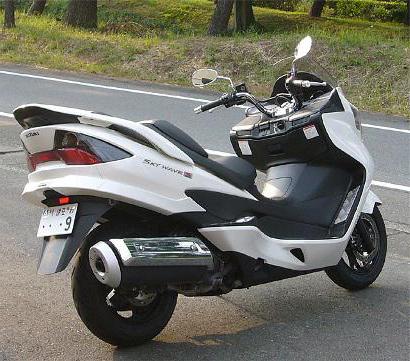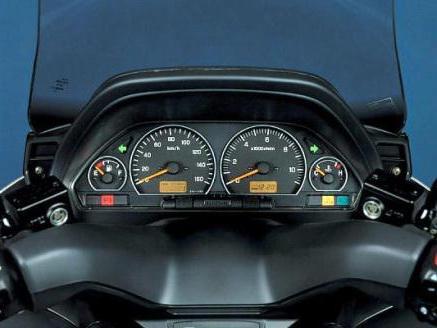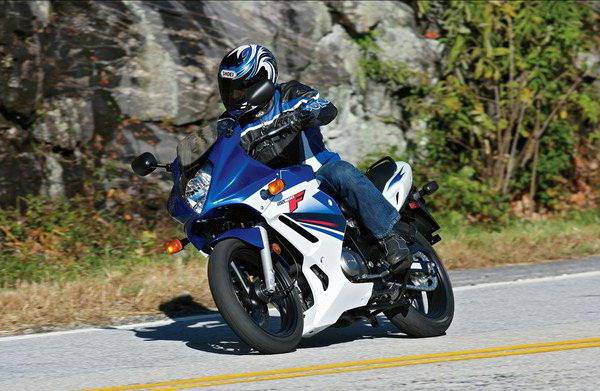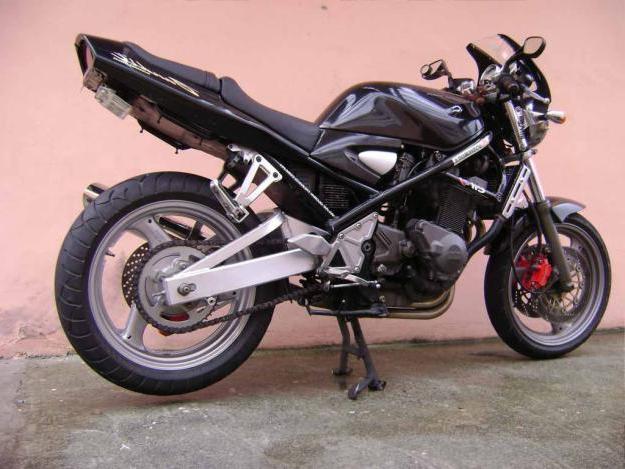Japanese Maxi-Suzuki Skywave 400 (photo of himare placed on the page) - this is a modern means of transportation in a metropolis. The car is inferior in maneuverability to the brisk bikes with 125 cc / cm engines, but the level of comfort at the scooter is much higher. Suzuki Skywave 400 is a complete analogue of the model Honda Silver Wing 400, if you consider these two scooters in terms of technical parameters. The difference is observed on the engine: the "Silver" has two cylinders, and "Suzuki" is equipped with a single-cylinder engine.

Suzuki Skywave 400: specifications
Model "Skyway 400" - this is the only Japanese maxi-scanner, which is produced with four types of body. Modifications are denoted by the numbers 41, 42, 43, 44.
- Case 41 (produced since 1998) - without a tachometer, with one headlight, a small luggage compartment, carburetor injection.
- Corps 42 (release since 2000) - lack of a tachometer, one headlight, a large trunk, two small glove box, a carburetor.
- Case 43 (produced since 2002) - injector injection, two headlights, tachometer, combined brake.
- Case 44 (produced since 2006) - injector, two headlights, fairing, tachometer, one large glove box and two small, volumetric trunk, combined brake.
Overall and weight parameters:
- length of scooter - 2270 mm;
- the height along the rudder line is 1385 mm;
- Seat height - 710 mm;
- width - 760 mm;
- capacity of gasoline tank - 12 liters;
- dry weight scooter - 150 kg;
- fuel consumption per 100 km - 3 liters;

Model Suzuki Skywave 400 (for the European marketname Burgman) is released from 1998 to the present in different versions. During the entire production period, the scooter twice passed restyling. Modernization concerned mainly the front guard, the running gear, brakes and electrical equipment. The engine was not upgraded, as its parameters were flawless and did not leave much to be desired.
Power point
The Suzuki Skywave 400 engine is a well-balanced unit, its restrained power turns a motor scooter into a two-wheeled liner, silently trailing along the wide city highways.
- type of motor - four-stroke, single-cylinder;
- fuel - high-octane gasoline AI 95;
- power - 33 liters. from. at a speed of 1400 rpm;
- torque twisting - 35 newtonometers, at 1300 rpm;
- gas-distributing mechanism (GRM) - two-shaft, four-valve;
- drive to the rear wheel - CVT.

Motor Suzuki Skywave 400, the characteristics of whichcomplete with a variator transmission look quite thorough, allows you to develop a speed of up to 120 kilometers per hour. However, the manufacturer does not recommend operating the machine at high speeds. There is no such thing as a "racing scooter". Relatively small wheels are afraid of unevenness, scooter can throw, and then there will be a skid.
Chassis
Both scooter suspensions, its elongated base, angledeparture of the front wheel - everything is designed for a stable ride on a flat road with a hard surface. 13-inch wheels provide a soft stroke, and the smooth draft of the motor - the movement without jerks at speeds ranging from 28 to 100 kilometers per hour. The front suspension is single-pole, with effective lever cushioning and vibration damper. The mechanism is attached to the reinforcing spring. Rear suspension - hinged short-arm with adjustable mono-shock absorber. Due to the low center of gravity of the scooter is stable on the course, steadily passes through the turns. However, in small-radius bends, the machine needs to reduce speed, since the lower part of the hull can hit the asphalt when it is tilted excessively. Affects insufficient ground clearance.
Comfort
Модель Suzuki Skywave 400 оснащается мягким double seat, based on polyurethane filler. The seat is reinforced with steel springs in order to keep the shape and give elasticity. The configuration is complicated, the seat for the passenger is less than the driver's, however, trips to short distances leave a favorable impression of comfort.
По удобству посадки и эргономичности "Скайвей" is in the first place among all Japanese scooters and motorcycles. However, the adaptation of the machine to the Japanese consumer is felt, everything is as if calculated for a small increase. A man above 180 centimeters sits down on the scooter with some uncertainty. However, in a short time you can get used to the parameters of the seat, floor and footboard.

"Скайвей 400" оснащается невысоким ветровым glass, which effectively protects against head wind and even rain. The angle of inclination of the transparent module is calculated in such a way that counter wind flows around it and an air bag is created. The motorcyclist and the passenger are thus in a kind of "dead zone" and feel comfortable enough.
Devices
Maksiiskuter "Skyway Suzuki 400" is equipped witha modern panel with a set of digital sensors. On one line there are circular dials of a speedometer and a tachometre, two compact indexes are located nearby: a level of fuel and temperature of heating of the engine. Below, in the center, the ignition lock is built in. The instrument panel is strictly symmetrical, there are two small buzzers at the edges, which give beeps when there is a malfunction in the engine or other abnormal situation associated with the chassis. In addition to the appearance of an audible warning, the red light on the instrument panel lights up.

Customer's opinion
Owners of the maxi-skater Suzuki Skywave 400, reviewswhich are generally positive, note first of all the comfortable sensations when driving on roads with an even surface, smooth running and inaudible operation of the engine. However, all buyers agree that on the road with unevenness the comfort level is significantly reduced. The front wheel transmits impulses through the steering wheel, which make it difficult to operate the scooter. And the rear suspension throws the passenger, and this happens chaotically. To avoid shaking, you have to reduce the speed to a minimum and move, carefully circling hummocks and irregularities.
В остальном владельцы не видят недостатков.The motor's power is more than sufficient, its acceleration makes it possible to make a jerk if necessary and to go forward if the road situation demands it. Or, on the contrary, in time to stop, the benefit of disk ventilated scooter brakes are highly efficient.












